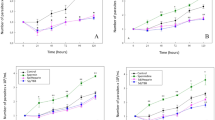Abstract
In vitro differentiation of pleomorphic blood-stream forms ofTrypanosoma brucei to procyclic culture forms occurred rapidly and at high rates at 27°C in a culture medium containing 1 mM cis-aconitate as the transformation-inducing agent. Citrate was required at a much higher concentration (10 mM) to produce a similar transformation rate. The highest percentage of transformed cells was obtained when bloodstream-form trypanosomes were treated with pronase in the absence of a feeder-cell layer. However, under these conditions, the amount of procyclic forms obtained after 72 h was lower than that obtained in the presence ofcis-aconitate. Trypsin was also capable of inducing transformation in the absence of a feeder-cell layer, but this treatment again resulted in low numbers of transformed cells. Blood-stream-form trypanosomes were incapable of taking up citrate to any significant extent and the citrate content of these stages was negligible. After 72 h of exposure to citrate (3 mM), intracellular levels of this compound remained very low (<1 nmol (109 cells)−1), increasing in established procyclic stages to approximately 1.7 nmol (109 cells)−1. These observations suggest that the tricarboxylic acid (TCA)-cycle metabolite-dependent transformation may be initiated externally to the trypanosome cell membrane. The ability of both citrate andcis-aconitate to bind calcium and, thus, to reduce the concentration of this cation in the culture medium was found not to be responsible for the triggering effect on trypanosome transformation. Citrate levels in tsetse fly body fluid were found to be far below those required to induce trypanosome transformation in vitro. Since proteolytic enzymes can effectively induce this process, these enzymatic components may be of greater physiological relevance as environmental stimuli for the differentiation process than are the TCA-cycle metabolites.
Similar content being viewed by others
References
Bass KE, Wang CC (1991) The in vitro differentiation of pleomorphicTrypanosoma brucei from bloodstream into procyclic form requires neither intermediary nor short-stumpy stages. Mol Biochem Parasitol 44:261–270
Brown RC, Evans DA, Vickerman K (1973) Changes in oxidative metabolism and ultrastructure accompanying differentiation of the mitochondrion inTrypanosoma brucei. Int J Parasitol 3:691–704
Brun R, Schönenberger M (1979) Cultivation and in vitro cloning of procyclic culture forms ofTrypanosoma brucei in a semidefined medium. Acta Trop (Basel) 36:289–292
Brun R, Schönenberger M (1981) Stimulating effect of citrate andcis-aconitate on the transformation ofTrypanosoma brucei bloodstream forms to procyclic forms in vitro. Z Parasitenkd 66:17–24
Cheeseman M, Gooding R (1985) Proteolytic enzymes from tsetse flies,Glossina morsitans andGlossina palpalis (Diptera: Glossinidae). Insect Biochem 15:677–680
Czichos J, Nonnengaesser C, Overath P (1986)Trypanosoma brucei: cis-aconitate and temperature reduction as triggers of synchronous transformation of bloodstream to procyclic trypomastigotes in vitro. Exp Parasitol 62:283–291
Dagley S (1974) Citrat: UV-spektrophotometrische Bestimmung. In: Bergmeyer HU (ed) Methoden der enzymatischen Analyse, 3rd edn. Verlag Chemie, Weinheim, pp 1607–1611
Durieux P, Schütz P, Brun P, Köhler P (1991) Alteration in Krebs cycle enzyme activities and carbohydrate catabolism in two strains ofTrypanosoma brucei during in vitro differentiation of their bloodstream to procyclic stages. Mol Biochem Parasitol 45:19–28
Fairlamb AH, Opperdoes FR (1986) Carbohydrate metabolism in African trypanosomes, with special reference to the glycosome. In: Morgan MJ (ed) Carbohydrate metabolism in cultured cells. Plenum Press, New York, pp 183–224
Frevert U, Herzberg F, Reinwald E, Risse H-J (1986) Morphological changes inTrypanosoma congolense after proteolytic removal of the surface coat. J Ultrastruct Mol Struct Res 94:140–148
Ghiotto V, Brun R, Jenni L, Hecker H (1979)Trypanosoma brucei: morphometric changes and loss of infectivity during transformation of bloodstream forms to procyclic culture forms in vitro. Exp Parasitol 48:447–456
Giffin BF, McCann PP (1989) Physiological activation of the mitochondrion and the transformation capacity of DMFO induced intermediate and short-stumpy bloodstream form trypanosomes. Am J Trop Med Hyg 40:487–493
Giffin BF, McCann PP, Bitonti AJ, Bacchi CJ (1986) Polyamine depletion following exposure toD,L-difluoromethylornithine both in vivo and in vitro initiates morphological alterations and mitochondrial activation in a monomorphic strain ofTrypanosoma brucei brucei. J Protozool 33:238–243
Gruenberg J, Sharma PR, Deshusses J (1978)d-Glucose transport inTrypanosoma brucei. Eur J Biochem 89:461–469
Imbuga MO; Osir EO, Labongo VL, Darji N, Otieno LH (1992) Studies on tsetse midgut factors that induce differentiation of bloodstreamTrypanosoma brucei brucei in vitro. Parasitol Res 78:10–15
Köhler P (1989) Nutrition and metabolism. In: Mehlhorn H (ed) Parasitology in focus. Springer, Berlin Heidelberg New York, pp 412–453
Lanham SM, Godfrey DG (1970) Isolation of salivarian trypanosomes from man and other mammals using DEAE cellulose. Exp Parasitol 28:521–534
Levenbook L, Hollis VW Jr (1961) Organic acids in insects. I. Citric acid. J Insect Physiol 6:52–61
Mancini PE, Patton CL (1981) Cyclic 3′, 5′-adenosine monophosphate levels during the developmental cycle ofTrypanosoma brucei brucei in the rat. Mol Biochem Parasitol 3:19–31
Nwagwu M, Okenu DMN, Olusi TA, Molokwu RI (1988)Trypanosoma brucei releases proteases extracellularly. Trans R Soc Trop Med Hyg 82:577
Overath P, Czichos J, Haas C (1986) The effect of citrate andcis-aconitate on oxidative metabolism during transformation ofTrypanosoma brucei. Eur J Biochem 160:175–182
Ryley JF (1962) Studies on the metabolism of protozoa. 9. Comparative metabolism of bloodstream and culture forms ofTrypanosoma rhodesiense. Biochem J 85:211–223
Simpson AM, Hughes H, Simpson L (1985)Trypanosoma brucei: differentiation of in vitro grown bloodstream trypomastigotes into procyclic forms. J Protozool 32:672–677
Voorheis HP, Bowles DJ, Smith GA (1982) Characteristics of the release of the surface coat proteins from bloodstream forms ofTrypanosoma brucei. J Biol Chem 257:2300–2304
Yabu Y, Takayanagi T (1988) Trypsin-stimulated transformation ofTrypanosoma brucei gambiense bloodstream forms to procyclic forms in vitro. Parasitol Res 74:501–506
Author information
Authors and Affiliations
Rights and permissions
About this article
Cite this article
Hunt, M., Brun, R. & Köhler, P. Studies on compounds promoting the in vitro transformation ofTrypanosoma brucei from bloodstream to procyclic forms. Parasitol Res 80, 600–606 (1994). https://doi.org/10.1007/BF00933009
Received:
Accepted:
Issue Date:
DOI: https://doi.org/10.1007/BF00933009




